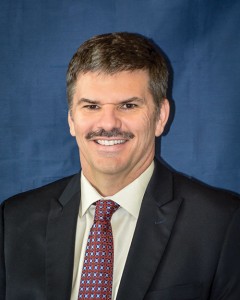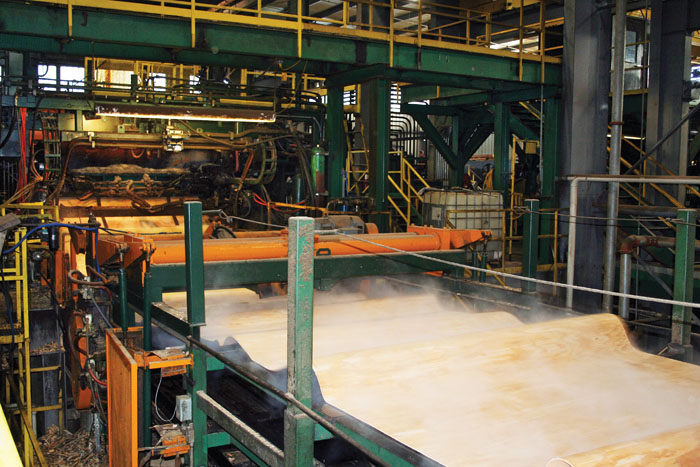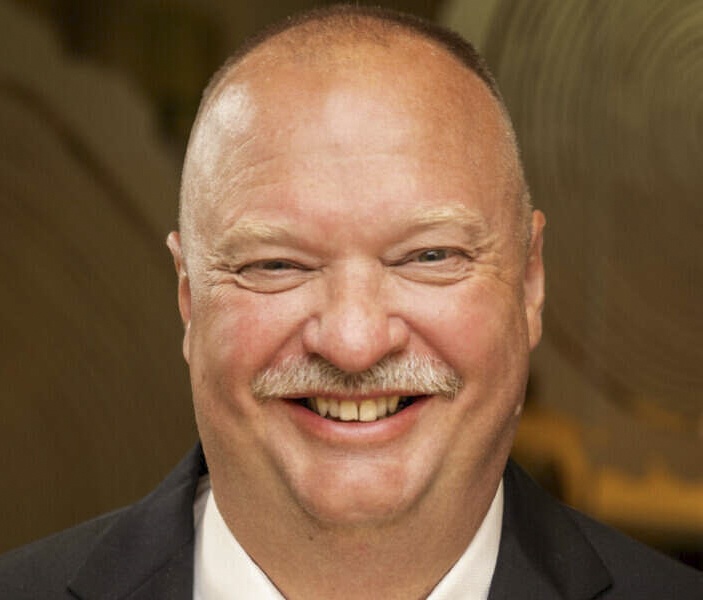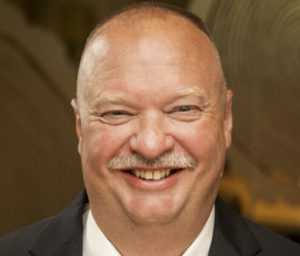by Site Manager | Mar 8, 2024 | News
Godfrey Forest Products Announces New OSB Mill For Maine
By Rich Donnell
Godfrey Forest Products, with multi-investor backing, has announced plans to build an 800MMSF annual production capacity brownfield oriented strandboard (OSB) plant in Jay, Maine, at the site of a paper mill known as the Androscoggin Mill, which closed in 2023. The company, led by John Godfrey, renown for his development of OSB plants since the early 1980s, hopes to gain necessary permitting within a year and begin construction thereafter. Jay is approximately 65 miles due north of Portland, Maine.
The project announcement was held March 8 at the Androscoggin Mill, with Governor Janet Mills leading off. “I still remember how I felt in April 2020 upon hearing of the digester explosion, Mills said. “I was concerned of course about the safety of the employees, but also for the future of the mill and this community.”
She said it’s been a priority to bring business back into the community since the mill’s closing, and referred to the Godfrey OSB announcement as “one significant project” for this property, and cited Godfrey’s long and successful history with OSB project development. She said the mill would provide 125 jobs in addition to construction jobs.
State Senator Lisa Keim (R-Oxford) recalled how generations of family and friends had worked at the mill. “Seeing the paper mill go silent hit us all very hard,” she said. “The announcement today brings back hope and opportunity. Jay is going to be a mill town once again. It’s a revitalization.”
Godfrey said at age 75 he might have been inclined to retire, “but it’s so much fun building OSB mills, why not one more round?”
Born in Bangor, Maine, Godfrey said when heard of the problems at the paper mill and ultimate closure, he saw an opportunity to redirect some of the unused pine pulpwood tonnage into a facility with ready-made infrastructure such as utilities, railroad tracks, excellent Northeast markets for wood products, and he emphasized that labor with manufacturing experience was plentiful in the area.
Godfrey, speaking from where he expected the finishing line will be located, estimated two and a half years until the beginning of production—following environmental permitting, equipment selection, removing existing buildings, construction of the plant, equipment installation and startup.
Godfrey said wood products will help to alleviate the sting of lost pulp and paper manufacturing in the state. “Maine is devoid of pulp mills now. The amount of wood is considerable.” Environmentally speaking, he added that “building materials is the ultimate storage of carbon from the atmosphere. It’s basically locked up for good.”
Godfrey wouldn’t reveal the investment figure, but said it was in the hundreds of millions of dollars, and he noted that the first million had come from the Maine Technology Institute.
International Paper built the Androscoggin Mill in 1965 and sold it to Verso Paper in 2006, which sold it to Pixelle Specialty Solutions in 2020. An explosion in the pulp digester area in spring 2020 did major damage and the mill never recovered.
An investment partnership purchased the property in early 2024, from which Godfrey Forest Products purchased just shy of 100 acres.
In recent years Godfrey was on the cusp of building an OSB plant at a procured site in Winslow, Ariz., as part of the U.S. Forest Service 4 Forests Restoration Initiative (4FRI), which was intended to treat and improve forest health conditions on more than 2.5 million acres across four Arizona national forests while establishing wood products manufacturing and biomass processing infrastructure.
But the Forest Service couldn’t piece the plan together and in 2021 canceled the bid-award phase, which included Godfrey’s bid for an OSB plant. In addition to a site for the plant, Godfrey had completed an engineering design, preliminary air work, and had a number of contractual relationships lined up.
Educated at Harvard College and Harvard Business School, Godfrey’s career started in Maine with Great Northern Nekoosa where he held several manufacturing and financial positions, and oversaw timberlands. In 1980, he left GNN and formed Godfrey Forest Products to develop an OSB mill in northern Maine. The mill, at Houlton (New Limerick), was developed and built in a partnership with Louisiana-Pacific Corp. Shortly after startup in 1982, Godfrey sold his interest in the facility to L-P. He proceeded to develop and execute a plan for the first OSB mill in Europe, founding Highland Forest Products at Inverness, Scotland in 1983. He served as Managing Director and CEO of HFP through startup and into successful operation. After several years of operation, HFP was acquired by Norbord.
Godfrey then assembled an investment partnership to acquire a defunct particleboard mill at Miramichi, New Brunswick in 1994. He led the formation of Eagle Forest Products and Chatham Forest Products, which reconstructed the Miramichi mill into an updated OSB facility. The mill operated three years and was sold to MacMillan Bloedel.
The monthly Panel World Industry Newsletter reaches over 3,000 who represent primary panel production operations.
Panel World is delivered six times per year to North American and international professionals, who represent primary panel production operations. Subscriptions are FREE to qualified individuals.
Complete the online form so we can direct you to the appropriate Sales Representative. Contact us today!

by Site Manager | Mar 17, 2015 | Uncategorized
 EDITOR’S NOTE: Grady Mulbery is vice president, manufacturing, at Oregon-based Roseburg. He oversees all manufacturing facilities throughout the company. Mulbery began his career as a facility manager for Willamette Industries at the Eugene, Ore. MDF facility. He held various management positions at Weyerhaeuser Company from 2002-2007 and was director of operations at SierraPine. He joined Roseburg as vice president of composites manufacturing in 2011. He currently serves as chairman of the Composite Panel Assn.
EDITOR’S NOTE: Grady Mulbery is vice president, manufacturing, at Oregon-based Roseburg. He oversees all manufacturing facilities throughout the company. Mulbery began his career as a facility manager for Willamette Industries at the Eugene, Ore. MDF facility. He held various management positions at Weyerhaeuser Company from 2002-2007 and was director of operations at SierraPine. He joined Roseburg as vice president of composites manufacturing in 2011. He currently serves as chairman of the Composite Panel Assn.
PW: Your veneer facility at Weed, Calif. sustained a fire last September 15, but it’s our understanding the company and the community rallied quickly and that the mill is running again.
Mulbery: That was a great company success story. It was handled well by all different functions within the company especially the people at Weed. We were able to meet our veneer needs and our customers’ needs by moving some people from California up here (to Oregon) to run some lathes that were down to maintain internal veneer supply. We got the Weed facility up and running in three weeks, with the exception of the cogeneration facility, which will be on line in March. This has been a great reflection of the company and the culture of the company.
PW: What’s the status and pace of your operations in general coming out of the recession?
Mulbery: For most of our segments it’s been fairly steady in 2013 and 2014. The big move up happened in the latter part of 2012. Engineered wood continues to be the strongest segment. There tends to be more demand there. The repair and remodel segment has helped us. We’ve been able to run the operations at reasonable capacity. The toughest segment has been particleboard. That’s had the slowest recovery.
PW: Have you done much project upgrade at your plants?
Mulbery: We’ve started doing projects in the last 18 months, more so than in the past five years. A lot of that is deferred maintenance. Some major projects include some upgrades to our primary breakdown system at the stud mill, an upgrade of our Missoula (Mont.) particleboard plant, where we replaced an old forming line with an existing forming line we had at a facility that we had shut down. We’re in the middle of some automation projects in our plywood group but most them are still several months away from being operable.
PW: What’s the status of the robotics technology that you implemented in certain areas of your operation?
Mulbery: We have several. We utilize them. They still have their function. We continue to work on how to utilize them more efficiently and look at other things we can do with them. But yes we continue to utilize them.
PW: How does Roseburg approach new product development?
Mulbery: Fundamentally we’re trying to keep things as simple as we can. We try to exploit what we do well. If certain things come along that make sense, something we can adopt from a current product line, we take a look at that in conjunction with sales and technical people and evaluate if that makes sense. Can we make money at it? Is there enough market share? Can we scale it up? Is there anything to work with, operating off our platform, or what does it take to adjust our platform to be able to do something like that? So it’s really a collaborative effort, but we look at it as how can it add value to what we do, knowing what our core business is. We really work hard to try to keep things simple. We have an integrated model which is complex enough.
PW: Roseburg has at times been aggressive with enhancing the culture of the company, while implementing business models such as Lean, performance metrics, team collaboration. What’s required at the manufacturing level for those things to evolve like they should?
Mulbery: It takes strong plant managers and strong leadership at the sites. We’ve continued down those tracks. We’ve modified certain things. Our focus has been to do the basics well, fundamentally understand the gaps and what we have to do to close them and make sure we have the right people in place with the right tools to make it happen. It’s a continuous work and process to get better. As a former mentor of mine used to say, “you never arrive.” You’re always trying to come up with the next best approach, but we really work hard at empowering our leadership to understand what we need them to go after.
Over the last couple of years we’ve embarked on a team-based collaborative management style. We’ve implemented that within the different businesses and now we’re at the stage where we’re starting to implement it in some of our operations. It’s having your team leadership commit to directions and decisions and everybody getting on the same page. You have the disagreements behind closed doors, and then once you get a commitment go do it. That’s been a real focus for us as a company and that transcends into the manufacturing side.
Also we’re putting a whole lot more emphasis on safety performance. Not just going out and trying to hit a number, but making sure we have the right resources, the right tools, and people understanding culturally we need them to work safe, we want them to work safe, so we’ve made a strong effort over the last 18 months to get that message out and make those changes.
PW: How does Roseburg approach finding high quality personnel?
Mulbery: During that four- or five-year swoon a lot of the talent in our industry left or retired from it. As we look forward, we recruit and hire the best talent we can, but we also embark heavily on internally developing people. Fundamentally we’ve started doing several different things to develop younger people over time. That’s been a real concerted effort. Especially as you look long-term, we’ve just got to develop our own.
PW: How does Roseburg maintain leadership positions in so many product segments?
Mulbery: We’ve got an integrated model. We’ve got internal log supply and our goal is to add value to that. We have a higher margin product portfolio for the most part and we try and spend our energy there.
In everything we do, we strive to be a top quartile performer—making sure that our (manufacturing) operations are as competitive as possible. How can we automate things, how can we get more efficient? What type of projects can we look at that can really advance us, realizing that we’re competing globally with several of our segments? Additionally, with the currency dynamics, that pressure is only increasing.
PW: What is your perception of today’s particleboard industry? Any product trends developing?
Mulbery: It’s been the slowest segment to recover since the great recession. It’s still a very tough business. There’s plenty of supply. But it has gotten better since the bottom of the downturn. It’s a large portfolio business for us. We have a tremendous amount of melamine capacity that goes with it. We have very strong positions in both PB and melamine in North America. We restructured back in 2011 and 2012 and we believe the segment will continue to get better and we’re positioned to do well in it.
Regarding product trends, there continues to be slow movement toward lighter weight products. This is one trend that I think will continue and likely accelerate given the continuing shift in furniture markets to lighter weight products. Additionally, freight continues to be such a large part of the delivered cost to a customer.
PW: Are you optimistic about your engineered wood products business?
Mulbery: Everybody is optimistic that it still has a long term upside. It’s continues to have fairly good growth coming out of this downturn. It continues to have good growth numbers relative to other product segments. We’ve done some internal automation projects for efficiencies that will benefit us as we go forward.
PW: Does Roseburg have an interest in cross laminated timber?
Mulbery: We’re not active in the segment. We monitor it and pay attention to what’s going on there. It will be interesting to see how well it gets off the ground and what it turns in to. We’re of the opinion that time will tell. PW

by Site Manager | Apr 27, 2012 | Update
Organizers of the new Timber Processing & Energy Expo report that 65 equipment and supplier companies have signed up to exhibit during the October 17-19 event to be held at the Portland Exposition Center in Portland, Ore. Those exhibitors have reserved 21,000 sq. ft. of booth space, as of early April, meaning the event is more than 60% sold out.
“And we’re still six months away,” comments Co-Chairman Rich Donnell, who is also the Editor-in-Chief of Panel World magazine and Hatton-Brown Publishers, Inc. “The show is almost selling itself, which indicates to me that companies are anxious to experience a new venue in the Northwest.”
Panel World is affiliated with Hatton-Brown Expositions, which is the show producer. Panel World along with Hatton-Brown publications Timber Processing and Wood Bioenergy are the magazine hosts of the event.
The Portland Expo Center is conveniently located off Interstate 5 between downtown Portland and Vancouver, Washington. It’s only minutes from the Portland International Airport and has immediate access to the Max Light Rail.
TP&EE is scheduled for Hall D, which encompasses 72,000 sq. ft., nearly half of which will be sold as exhibit space. The overall Exposition Center sits on 60 acres and includes five halls with 330,000 sq. ft. The facility hosts more than 100 events annually, attracting in excess of 500,000 attendees.
Exhibitors will cater to an attendee base of primary producers of lumber, veneer/plywood and engineered wood products as well as wood-to-energy producers.
The previous Portland show under a different ownership simply ran its course, Donnell says. “It was a great show for many, many years. But I believe the machinery community and the mill community are looking for a new event that is organized and operated by people who are hands-on with the wood products industry. In fact people have been asking us for years to do this.”
Donnell says that one area where the previous Portland show became increasingly lacking was the veneer/plywood industry. “It became almost purely a lumber show, and certainly lumber is a major portion of it,” Donnell says. “But the veneer/plywood sector is equally as big and we intend for our new event to represent it equally well.”
Panel World magazine was one of the hosts of the recently concluded Panel & Engineered Lumber International Conference & Expo (PELICE) in Atlanta. Asked what the difference is between PELICE and the new Portland show, Donnell responds, “PELICE was primarily a conference with great support from the exhibitor community. TP&EE is primarily a machinery exhibitor show.”
However, Donnell adds that TP&EE will have a conference element to it, more specifically called “Workshop Morning.” It will be held on the morning of October 18 and include three subject areas, with multiple presenters addressing each. The topics are: Veneer Lathes & Dryers; Wood Energy Systems; and Sawmill Scanning & Optimization. The topics relate to the show’s three main areas of focus: veneer and panel production; wood-to-energy; and lumber production,
“We’re now beginning our promotion efforts to convince the mill community that they will thoroughly enjoy this event,” Donnell says. “Many of them, particularly in the panel sector, had quit coming to the Portland show because they weren’t getting enough out of it.”
Donnell adds that these same people are the readers of Panel World, Wood Bioenergy and Timber Processing magazines. “They know us. They know we’ll give this show 110% with them in mind.”
For information on exhibit space sales, contact Fred Kurpiel at 678-642-1238; e-mail [email protected].
For information on Workshop Morning, e-mail [email protected].
Also visit www.timberprocessingandenergyexpo.com.




